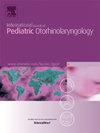在评估腺样体肥大时,我们是否还应考虑侧颈x线摄影?系统回顾和荟萃分析
IF 1.2
4区 医学
Q3 OTORHINOLARYNGOLOGY
International journal of pediatric otorhinolaryngology
Pub Date : 2025-05-23
DOI:10.1016/j.ijporl.2025.112389
引用次数: 0
摘要
腺样肥大是一种常见的儿童疾病,可导致显著的症状和并发症。早期诊断和治疗对于改善患者预后至关重要。虽然内窥镜检查是诊断的金标准,但其侵入性和成本是限制因素。侧位颈部x线摄影可作为评估腺样体肥大的有效选择。本研究旨在评估x射线在腺样体肥大的诊断和分级中的作用。方法:从成立到2024年10月,我们在四个数据库中进行了广泛的文献检索,检索了使用x射线评估腺样体肥大的研究,并将内窥镜检查作为参考检查。我们计算了每项研究的敏感性(SN)和特异性(SP),并将结果汇总到随机效应荟萃分析模型中。结果本系统综述纳入50项研究,涉及12266例腺样体肥大患者。合并分析显示,侧颈x线摄影诊断轻度腺样体肥大的SN为0.751,SP为0.893。然而,中度和重度腺样体肥大的这些值略有下降,中度腺样体肥大的合并SN为0.618,SP为0.714,重度腺样体肥大的合并SN为0.637,SP为0.834。结论颈部侧位片对轻度腺样体肥大的诊断具有中等敏感性和特异性,同时也强调了其对中度和重度腺样体增大的诊断局限性。临床评估和鼻咽镜检查仍然是评估腺样体肥大的最佳诊断方式。本文章由计算机程序翻译,如有差异,请以英文原文为准。
Should we still consider lateral neck radiography in the evaluation of adenoid hypertrophy? A systematic review and meta-analysis
Background
Adenoid hypertrophy is a common childhood disorder that can lead to significant symptoms and complications. Early diagnosis and management are crucial for improving patient outcomes. While endoscopy is the gold standard for diagnosis, its invasiveness and cost are limiting factors. Lateral neck radiography may serve as an effective alternative for evaluating adenoid hypertrophy. This study aims to assess the role of X-rays in diagnosing and grading adenoid hypertrophy.
Methods
From inception to October 2024, we conducted an extensive literature search across four databases on studies using X-rays to evaluate adenoidal hypertrophy, with endoscopy as a reference test. We calculated the sensitivity (SN) and specificity (SP) for each study and pooled the results in a random-effects meta-analysis model.
Results
Our systematic review included 50 studies involving 12266 patients with adenoid hypertrophy. The pooled analysis revealed a SN of 0.751 and SP of 0.893 for lateral neck radiography in diagnosing mild adenoid hypertrophy. However, these values slightly decreased for moderate and severe adenoid hypertrophy, with a pooled SN of 0.618 and SP of 0.714 for moderate adenoid hypertrophy and a pooled SN of 0.637 and SP of 0.834 for severe adenoid hypertrophy.
Conclusion
Our study demonstrates moderate sensitivity and specificity of lateral neck radiography for diagnosing mild adenoid hypertrophy while also highlighting its diagnostic limitations for moderate and severe adenoid enlargement. Clinical evaluation and nasopharyngoscopy remain the optimal diagnostic modalities in evaluating adenoid hypertrophy.
求助全文
通过发布文献求助,成功后即可免费获取论文全文。
去求助
来源期刊
CiteScore
3.20
自引率
6.70%
发文量
276
审稿时长
62 days
期刊介绍:
The purpose of the International Journal of Pediatric Otorhinolaryngology is to concentrate and disseminate information concerning prevention, cure and care of otorhinolaryngological disorders in infants and children due to developmental, degenerative, infectious, neoplastic, traumatic, social, psychiatric and economic causes. The Journal provides a medium for clinical and basic contributions in all of the areas of pediatric otorhinolaryngology. This includes medical and surgical otology, bronchoesophagology, laryngology, rhinology, diseases of the head and neck, and disorders of communication, including voice, speech and language disorders.

 求助内容:
求助内容: 应助结果提醒方式:
应助结果提醒方式:


